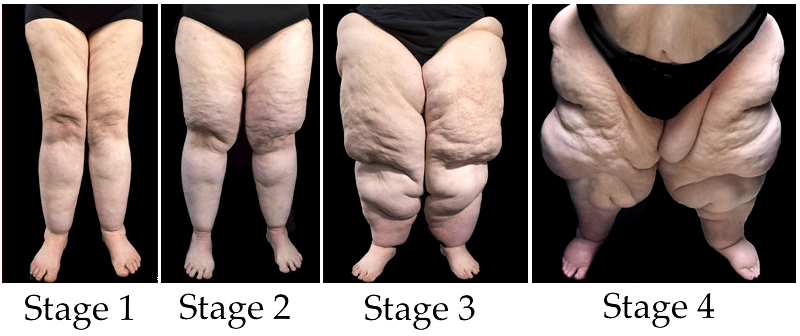Since 1940, Lipoedema has been recognised as a valid medical condition in women (Mayo Clinic), and yet still women with this condition are stigmatised and told to increase exercise, and lose weight.
Sadly, this advice comes, not only from friends and families, but often from medical professionals, personal trainers and gym staff. Little wonder then, that depression and eating disorders are commonly experienced by women with Lipoedema.
What is Lipoedema?
An inherited adipose ( fatty tissue ) disorder, mainly experienced by women, which usually manifests at puberty. It has metabolic, inflammatory and hormonal elements and is often associated with chronic venous and lymphatic insufficiency. Men are very rarely affected by Lipoedema.

Photo: the Lipedema Project
It is often the case that these symptoms are initially treated as the primary issue, and only much later is the Lipoedema recognised as the primary disorder.
How is it diagnosed?
Most commonly, Lipoedema is diagnosed by its visual characteristics. It is often first noticed following significant hormonal changes such as the onset of puberty, pregnancy and menopause.
Signs and symptoms
Waist is small compared to much larger bottom, hips and thighs. In initial stages, the legs are only affected as far as the knees, but as the condition progresses, it impacts the lower half of the legs.
Symmetrical increase in fatty deposits usually from the waist to ankles. Feet are not affected, and the condition is typified by “fat rings” around the ankles ( and if arms are affected, the wrists) known as the bracelet effect.
Lipoedemic fat pads accumulate on the upper thighs, and around the knees, resulting in abnormal gait, and knee and hip pain.
Legs are often very sensitive to touch and pressure and exercise is painful both during and after participation.
Non pitting oedema occurs, especially after long periods of sitting or standing. Skin is soft to the touch, as is the underlying fatty tissue.
Skin temperature is often lower on affected limbs, and can have an orange peel like appearance.
Affected areas bruise more readily than surrounding areas.
Hyper mobility.
Generally diets and intense exercise have little effect on Lipoedema, though a healthy diet and moderate exercise is important in Lipoedema management.
Frequently Lipoedema is identified within families, ie, My Grandmother, mother, Aunts, had “heavy legs”, “childbearing hips” etc. Whilst these people might never have been identified as having had Lipoedema, it is more likely that this history implicates the current symptoms in a Lipoedema inheritance.
Remember not all women suffer all of these symptoms, each person will have a different array of these symptoms, and some will vary, daily and seasonally, but as the we age, more symptoms become an issue.
The important thing to do is to have plans in place to reduce the severity, to self manage, and to provide the best support for your body you are able to.
Implications of Lipoedema
In recent research, respondents to a lifestyle survey indicated the profound impact on how women with Lipoedema lived their lives.
- 95% reported difficulty buying clothes
- 87% a significant reduction on quality of life,
- 86% low self esteem
- 83% avoided having photos taken
- 60% restricted social lives
- 60% feelings of hopelessness
- 47% self blame
- 45% eating disorders
Other issues included, ridicule, financial pressures from discrimination, lack of exercise due to harassment, marriage breakdown, the hazards of yo-yo dieting.
In general a lack of freely available information, about treatments, self help, and management strategies among the general population, has lead to isolation and embarrassment for many.
However this is changing and awareness is growing.
Treatment options
The first step is to secure a diagnosis. This sounds simple, but as previously alluded to, it may be the most complicated step you have to take!
Pain Management
Improved lymphatic flow, compression, MLD (manual lymphatic drainage), variable compression pumps,
Healthy eating and use of a low inflammatory diet
Low impact exercise, whole body vibration, weights, hydrotherapy and water based exercise, walking and Pilates are all helpful
Decongestive therapy or wrapping can help to reduce the volume of affected limbs in later stages of the disorder.
Surgery to reduce bulk and specialised liposuction are also options in more advanced Lipoedema.
It is important to remember, you have a Medical Condition, and Lipoedema is not a choice.
You can help your body by healthy exercise and with good nutrition, but a diet will not reduce Lipoedema.
In Australia, you can contact Lipoedema Australia for support and assistance.
The best thing you can do is take care of yourself, and be proactive by consulting therapists who know how to treat you.
Come and be treated by our Principal Therapist, Nicki Cooke, who is trained in Lipodema treatment.
If you’d like more information, please give us a call, or make a booking with Nicki today.